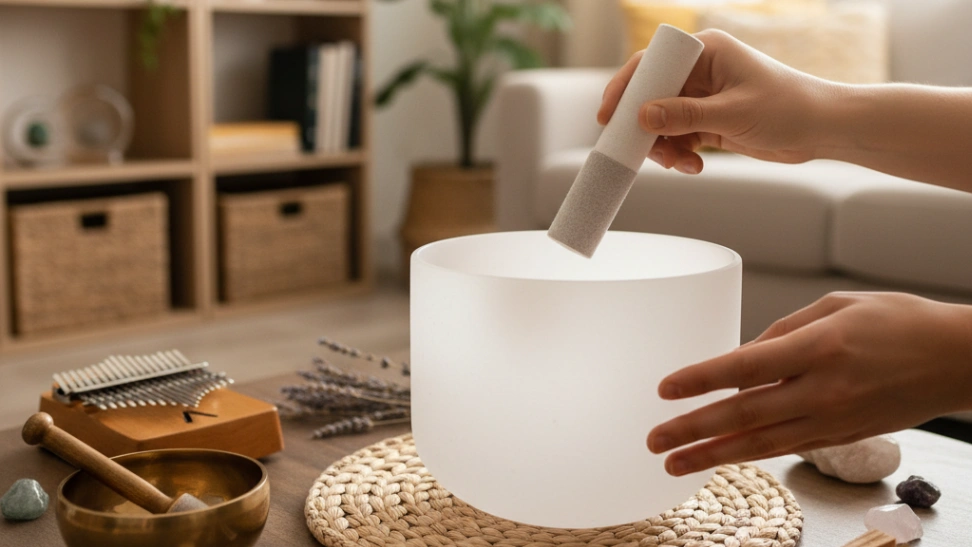The roots of sound healing stretch back thousands of years, interwoven with spiritual and healing traditions across various cultures. Ancient Egyptian priests used vowel sounds in healing rituals, believing specific vocal tones could resonate with different energy centers in the body. Indigenous cultures, from Australian Aborigines with their didgeridoos to Native American tribes with their drums and rattles, have long employed sound for ceremonial, trance-inducing, and healing purposes. In ancient Greece, Pythagoras famously studied the mathematical ratios of musical intervals and their effects on human consciousness and health, applying music to treat various ailments. The use of bells and chanting has been a cornerstone of Buddhist and Hindu practices for centuries, particularly in Tibet and Nepal, where Himalayan singing bowls (also known as Tibetan singing bowls) originated. These bowls, crafted from multiple metals, produce complex, resonant overtones used for meditation, prayer, and healing. The tradition spread throughout Asia and eventually to the Western world, gaining significant traction in the 20th and 21st centuries as part of a broader resurgence of interest in holistic and alternative therapies. Early pioneers in modern sound therapy explored the application of specific frequencies for pain relief, stress reduction, and psychological support, laying the groundwork for the diverse practices seen today. This rich historical tapestry underscores the enduring human belief in the transformative power of sound.
Modern sound healing integrates these ancient wisdoms with contemporary understanding of acoustics, neuroscience, and psychology. Practitioners often use a variety of instruments chosen for their specific vibrational qualities. Crystal singing bowls, made from quartz, produce pure, sustained tones that are believed to align with the body's chakras or energy centers. Gongs, with their vast array of harmonics and profound resonance, are frequently used in "gong baths," where participants are immersed in a cascade of sound, often leading to deep meditative states or altered consciousness. Tuning forks, emitting precise frequencies, are applied to specific points on the body, similar to acupuncture, to stimulate energy flow and promote localized healing. The human voice, through chanting, toning, or overtone singing, is also a powerful tool, allowing practitioners to directly imbue sound with intention and personal resonance. The scientific community is increasingly exploring the physiological effects of sound, from its impact on brainwave states (shifting from beta to alpha or theta for relaxation) to its potential to reduce inflammation, improve sleep, and even aid in cellular regeneration, though much of this research is still in its early stages. The appeal of sound healing lies in its non-invasive nature and its ability to bypass the analytical mind, allowing for direct emotional and energetic release.
Getting started with sound healing can range from passively receiving a "sound bath" to actively learning to play instruments and facilitate sessions. For many, the initial experience is as a participant in a group session or a one-on-one private healing. These sessions typically involve lying down comfortably while a practitioner plays various instruments around and over the body. The goal is simply to relax and allow the sound vibrations to wash over you, observing any sensations, emotions, or insights that arise. For those interested in deeper engagement, workshops and training programs are widely available. These courses teach the theory behind sound healing, how to play different instruments, develop listening skills, and understand the energetic and therapeutic applications of sound. Many aspiring practitioners begin with a single instrument, such as a Himalayan singing bowl or a crystal bowl, learning its nuances before expanding their repertoire. The journey is often deeply personal, combining artistic expression with a dedication to facilitating well-being for oneself and others. Building a personal practice can involve daily meditation with sound, exploring different instruments, and continually refining one's understanding of vibration and resonance.
The benefits reported by individuals engaging in sound healing are numerous and varied. Many describe profound relaxation, often reaching states comparable to deep meditation or even sleep, which can significantly reduce chronic stress and anxiety. The practice is also associated with improved mood, clearer thinking, and enhanced creativity, as the sound vibrations are thought to help clear mental clutter and open up new perspectives. Physically, participants sometimes report reduced pain, better sleep quality, and a general sense of revitalization. Emotionally, sound healing can facilitate the release of old traumas, grief, and other stagnant emotions, creating space for emotional resilience and inner peace. The holistic nature of the practice means that it addresses not just symptoms but aims to restore balance at a fundamental energetic level. While not a substitute for conventional medical treatment, sound healing is increasingly recognized as a valuable complementary therapy, supporting mental, emotional, and physical health by tapping into the body's innate capacity for self-regulation and healing. Its growing popularity reflects a societal shift towards seeking holistic and mindfulness-based approaches to health and well-being.



